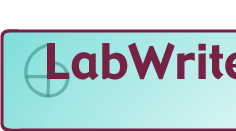SECTION ONE : Methods
Describing the lab procedure
Using
the notes you took while performing your experiment(s) and any other appropriate
sources, describe in paragraph form the experimental procedures you followed.
Be sure to include enough detail about the materials and methods you used
so that someone else could repeat your experiment as you performed it.
More
Help:
- In writing the Methods,
you need to rely primarily on the notes you took as you were doing the
experiment. Think of your audience as someone who does not know what
experiment you performed. Include enough details about both the materials
you used and what you did so that the audience has a clear picture of
the experiment.
- Write the procedure in paragraph
form. For relatively simple labs, one paragraph will do; more complex
labs will take multiple paragraphs. Keep the paragraphs relatively short
because it's hard for readers to process detailed information like this
without sufficient breaks.
- Avoid putting any results
of the lab in the Methods. Just describe what you did, not what you
found.
- Use the proper
past tense and passive voice. Methods are usually written in past tense
because you are describing what you have already done. They are also
typically written in passive voice ("Two ml. were pipetted
into a test tube"). However, your lab instructor may permit you
to use active voice, which uses first person, "I" or "we"
("We pipetted 2 ml. of the solution into the test tube").
More Helpful Hints:
- To make your description
of the experimental procedure clear, use appropriate transitional or
"sign post" words that indicate a sequence and help the reader
follow the sequence: step 1, step 2, step 3; first, then, finally; first,
second, third; after, next, later, following; etc.
- Include the methods you
used for both gathering data and analyzing the data.
- If your lab is complicated,
perhaps consisting of more than one experimental procedure, then consider
dividing your Methods into sections with subheadings.
- If you used what is considered
a standard procedure (one that competent scientists in the field are
likely to be familiar with) then there is no need to describe it in
detail. Simply state that you used that procedure, being sure to give
its common name. (If you are not sure about what standard procedures
are in your field, ask your lab instructor.)
- When describing an apparatus
or instrument, it may be better to include a sketch of it rather than
to try to describe it fully in words. This is especially useful in cases
where the apparatus is complex or designed by you. All you need is a
couple of sentences that give a general sense of the apparatus, and
then refer the reader to the figure that contains the sketch, the same
way you would refer the reader to tables or graphs.
|




